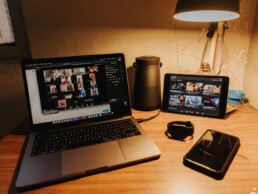Eight Steps for Marketing Your Virtual Event
While there’s no replacing the face-to-face networking, spontaneous exchange of ideas, commerce potential, and overall sensory experience associated with a live event, a virtual event can help corporations, associations, and other organizations achieve valuable business objectives. During the COVID-19 pandemic when gathering in person is not possible, pivoting to virtual events can keep brands top of mind, audiences engaged, and can help generate new leads. To create an audience for your next virtual event, consider these best practices.
Start with your virtual event strategy
Ensure your organization is aligned around the overall objectives of your virtual event. Write down, in priority order, everything you want to accomplish, e.g., audience engagement, revenue generation, lead generation, brand building, exposure for industry suppliers, establishment of thought-leadership, and more. Refer back to this list as you face decisions not just about marketing, but also about budget, content, delivery/technology, sponsorships, etc.
Define your audience
Who will be the most likely to participate in a virtual event - Look within and outside of your database to identify engaged and/or intellectually curious segments of your prospective audience.
Consider audiences from parts of the world you hadn’t marketed to before, industries or professions that have seen the cancellation of live events that serve them, and any other audiences who may be hungry for community and knowledge sharing in today’s new reality.
Create an event marketing tool kit
There are five essential tools that should be used to build an integrated campaign for a virtual event:
- A strategic brief
- A creative concept
- A messaging platform
- A tactical plan, and
- A resource allocation plan
By aligning on the creative, messaging, and tactical plan from the start, your team can more efficiently market your virtual event. When developing your tactical plan, keep the following considerations in mind: First, the customer journey timeline for a virtual event is greatly condensed compared to one for a live event. Second, because attrition rates of 50 percent (and higher) are common for virtual events, do not stop marketing to registrants. Ensure you funnel registrants into a separate campaign and convince them to show up.
Build a killer event website or landing page
After you’ve identified your goals, defined your audience, and built your event marketing tool kit, now it’s time to work on the focal point of your campaign — your website. Because your site will serve each key segment within your audience, make it flexible and comprehensive, but don’t lose sight of the fact that visitors want to get in and get out with minimal fuss.
Consider using forms to provide a quick way for cold leads to stay informed, setting cookies to remember user choices on return visits, and personalizing content blocks based on acquisition source, or, even better, past behavior data pulled from your automation platform or CRM.
Use a performance model to guide your approach
Start by estimating how many website visits it will take to generate the registration numbers you desire and then work backward from there to determine where the traffic will come from. By estimating how much traffic will be driven organically by email, digital ads, etc., you can set goals for impressions, engagement, and click-throughs.
Leverage your partners in promotion
If applicable, partner with your sponsors, speakers, and other ambassadors to promote the event as a way of elevating their exposure — and helping you extend your reach. Create a suite of easily customizable tools and messages they can use to invite their networks to participate.
Leverage your content
Don’t wait until your event to share valuable information. Tease out compelling content through guest blogs, speaker videos, and social media posts, to give your audiences a taste of what’s to come.
Know when to ask for help. If you’re new to the virtual event space, don’t go it alone. Lean on your event technology partner, agency resources, and firms that specialize in event marketing to fill in the gaps.
Written By: Kimberly Hardcastle-Geddes
Source: Freeman
How to Adjust Live Event Content for Virtual Events
Sometimes the unthinkable happens ? a disaster, a cancellation, an instance out of our control. As we?re seeing now, that can have a big impact on what we do as event professionals and how we gather as people to learn, network, and engage.
But with a switch in strategic thinking and the right partners for content and technology, you can pull off a virtual event that is every bit as exciting as your in-person plan.
Embrace the new opportunities
As you jump into virtual events, know that your virtual event strategy is not going to be 100% the same as your live event strategy. Adjusting your plan for virtual events opens up new possibilities that you must consider before moving forward.
First and foremost, revisit your goals and priorities. How do they need to change with a virtual event? Can they be expanded? Does anything need to switch out? Capture all of this information so that it?s handy to reference as you revisit decisions.
Another thing to consider ? going digital can mean getting even more data from your event. More insights means more ways you can show value, so it?s important to align ahead of time on the right metrics for your team to track.
Add to your audience
Once your goals are firmly in place, think about your audience ? that target is highly likely to change when you?re putting on a virtual event, simply because you have the ability to expand your reach beyond the confines of geography. And that expanded audience isn?t just about reach ? it also allows for more targeted, personalized messaging.
Consider adding other personas, industries, or more to your marketing list to expand that net even farther. Community is more important than ever before, and yours may be wider than you once thought.
Inject some personality
First and foremost, having a great moderator or emcee is critical for translating live events to the virtual space. It can be too easy for things to go off the rails, especially in a new format ? let alone having to work around potential connectivity issues, technology glitches, or any other surprises. That?s why having someone calm, engaging, and knowledgeable steering the conversations and providing transitions between elements is so important.
They can be the central guiding voice throughout the event that gives out important information, introduces new speakers, makes announcements, and more. Having the perfect personality in charge helps bring life to your event, helping attendees get more engaged and moving away from a scripted look and feel.
Break things up
You might think that having a captive virtual audience is the perfect opportunity to dive into a topic for a few hours at a time ? but think again. It?s even more vital to break up virtual event content into manageable chunks so that you don?t lose attendee attention and participation.
Ten to 15 minute sections are suggested for ideal content consumption. Between those sections, the content can be broken up by interactive moments, like taking some questions, leveraging a poll, or drawing for a prize. This helps attendees fully digest the content without feeling overwhelmed from a distance. Opportunities for networking can also be added between sessions to keep people engaged with one another as well as the content.
We highly recommend using a mix of pre-recorded videos along with live streaming for all virtual events. This gives you more control over your content before the event, allowing for editing, reshooting, or redesigning. This is a similar approach to successful television broadcasting. Then, you can take advantage of the live platform to generate great conversations and interaction with attendees.
Get engaged
Virtual events can be just as rich with inspiration and education as a face-to-face experience, but when people are working from their own spaces, it can be harder than ever to keep distractions to a minimum.
That?s why adding interactivity to virtual events is an absolute must to foster engagement and keep attention. There are lots of options that you can deploy in a way that makes the most sense for your audience, format, and content:
- Conversational formats instead of rote webinar standards can help attendees feel more relaxed and engaged during sessions, especially when you have a great moderator to keep things moving along and guests who add not just expertise, but energy to the event.
- Virtual lobbies not only help you with crowd control while you make last-minute adjustments, but they give attendees a valuable moment to chat and introduce themselves.
- Virtual product showcases can take the place of some of what attendees are used to seeing on the show floor. Think outside the box while also thinking about what tech attendees typically have at home. This can work for things like product walkthroughs, augmented reality experiences, and more.
- Feedback and Q&A sessions are the better way to handle audience interaction during a virtual event. Having these features built into your platform helps you manage the information flow, and you can pivot if necessary based on the feedback you receive. This also boosts engagement and helps ensure that conversations are a two-way street. The more attendees interact and engage, the more value they find in your event.
- Polls and surveys help break up your content flow and provide a moment of breathing room for presenters while also getting valuable feedback straight from the audience. That data can provide interesting insights during and after presentations, as well as a read on the room to see who?s actually engaging.
- Contest or raffle elements built into your event add some fun and excitement while working as an additional incentive to keep people engaged with your content. They could even be a part of a virtual sponsorship opportunity!
Connect and curate
When events are virtual, it?s that much harder for attendees to network among the group and meet with like-minded individuals. That?s part of what makes live events so special ? and something we don?t want to lose.
Personalization and personal connection, wherever we can create it, is a crucial way to keep people engaged and help a virtual event feel as genuine as a live experience.
Some solutions have features that allow you to split a virtual meeting into smaller groups, like breakout sessions. This can be utilized to create focused discussions around different questions, areas of expertise, interests, and more.
Having not just speakers, but attendees share short bios and connect via channels like LinkedIn helps people get a sense of who?s on the other side of the screen. And creating groups on Facebook or Slack channels focused on the event and specific topics is a great way to keep people in touch for post-event communications, discussions, and more.
By keeping these tips in mind, as well as working with a great partner that can help you with technology infrastructure, strategy, marketing, and more, you can successfully transition your live event to a virtual one without missing a beat.
Article By: LOUIS LAYTON
Source: Freeman
Keep Company Culture with a Remote Workforce
It's no secret that we are amid something incredibly life changing. Businesses are going through many challenges and changes as companies transition to a remote workforce. If we know one thing has stood the test of time, it is the work ethic of employees.
Any emotional response from leadership can send a ripple through the company, good and bad. As we weather through this storm, every leadership team must align with how to encourage and appreciate all individuals within a company.
1. Recognize Small Wins
If fortunate enough, many individuals have already begun a remote working schedule. Even with progressive work environments, not everyone has the foundation in place to adapt to this new remote workforce structure. Technology may lapse, calls may drop and a new wave of company culture forms out of the idea of going to work in pajamas.
To keep a pulse on everyone's spirit, celebrate small wins. Every person on this planet is affected by this current pandemic. No matter the struggle, small or large, we are in this together. When leadership keeps a positive outlook by recognizing the good with the bad, these habits will trickle down to the rest of the team.
2. Appreciate Everyone Individually
Whether your team consists of a few employees or your company can fill half a football stadium, everyone is unique and interprets recognition differently. In order to adequately accommodate for each person's needs, it is important to connect with all of them individually.
Find the time to appreciate the hard work and initiative. From a simple 'thank you' to a gift card to the grocery store, appreciation goes a long way.
If your company has the means, formal modes of recognition are an easy way to celebrate individuals. Whether it is a commemorative medallion for a kooky version of work-from-home office Olympics, or an award for hitting those Q1 sales goals, rewards in the physical form are always a safe approach to recognition.
3. Give Support Often
There should be no short supply of appreciation. During this time, employees are not just the building blocks to a positive work culture. They are quite literally keeping every company afloat. Every day should be filled with support for those individuals that are putting all of their best efforts forward.
Take a few minutes each day to plan out how to support others. Is there something you can do as a manager to appreciate your employees differently today? Switching up the form of praise and appreciation each day will give employees a boost in morale. Not only will this give them something to look forward to, but this anticipation can positively impact their lives.
4. Be Genuine
Genuine appreciation will prevail during this difficult work environment. Appreciation validates a worker's efforts, but a genuine approach can increase the effect tenfold. By not just praising those around you but doing so with genuine interest and appreciation, employees will remember the sincerity for months afterwards.
A boost in productivity can occur during this time, but do not lose sight of what is important. Your employees are going to great lengths to keep their jobs functioning as normal as possible. In turn, receiving appreciation and recognition for their hard work will go a long way.
Find out what other small ways you can show big appreciation. From experience, our remote workforce is ready to help shape your recognition program to its fullest potential. Connect with us today.
Written By: Samantha Mikos
See this article and more on Cristaux.com
Shipping Solutions if Your Event is Canceled
Amidst the rising concerns of the Coronavirus, it is becoming more common to postpone events with larger groups of attendees. In some extreme cases, event planners have outright canceled award shows. As the global status continues to evolve with further preventative measures, find out what options you may have from your award supplier.
While it is understandable that safety is the most important concern to address, we want to make sure that each award show planner knows that they have choices when it comes to the actual awards shipping.
Drop Ship to Individual Recipients
Likely to be the easiest solution if you find yourself in a bind, drop shipping is the highest recommendation. This is a great way to avoid any headaches with shipping logistics. With this option, the award shipments skip the middleman and will ship directly from the production fulfillment warehouse. Wipe your hands clean knowing you do not have to run around and ship each individual package yourself.
This takes the responsibility off your shoulders for ease of transfer. Also, if the event is in fact canceled, this is a great way for the recipients to still receive their honor right away.
When shipping from Cristaux, our Chicago-based production facility is taking substantial precautions to ensure that we ship each package with the highest quality and care.
Ship Directly to Company Office(s)
Similar to the drop shipping option, shipments to an office, or even multiple office locations, will help eliminate added stress. If an event is postponed and you have the extra space, you can house the inventory internally, or you can deliver the awards personally to the recipients.
This is also an alternative if the award recipients are internal employees. You can hand the awards out to recipients before or after the workday. If there are awards for employees at multiple offices, the process will still work just the same.
Postpone Event and Hold Inventory in Supplier Warehouse
Although this is not the last resort with awards shipping, this option is not ideal because many manufacturers will not have warehouse space to hold excess inventory. You may be lucky enough to have a vendor hold your inventory for an extended period of time. In this instance, your awards supplier will be allotted a holding fee.

This a good alternative if you know that your event will not be postponed for an extensive amount of time. If the show will be eventually rescheduled, this option is ideal. That way, when the time comes, you can ship the awards as normal.
The fee for this can range depending on the supplier, so make sure to get a quote before you decide to go ahead with this option.
Last Resort: Cancel the Order
This may seem like an easy option with awards shipping, but this is the most unfortunate and stress-inducing option for both parties. Not only will this cause a major supplier issue if the order is already in production, but more than likely there is contractual agreement that obligates you to pay a fee if you cancel. Oftentimes this fee is a heavy sum to counteract any supplier costs that incur with your order.
We understand that sometimes this is the only option that has been given. The important item to note is whether or not you will have to start this process again in the future. It might be ideal to be charged a holding fee instead and avoid any future setbacks if the event will resume in a few months.
Article by: Samantha Mikos
Visit Cristaux for the original article and more




